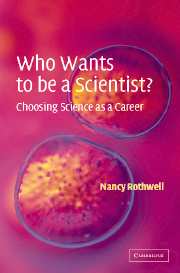Book contents
- Frontmatter
- Contents
- Preface
- 1 Introduction
- 2 Starting out in research
- 3 Getting down to research
- 4 Scientific ethics and conduct
- 5 Publish or perish?
- 6 Communication and getting known
- 7 Moving up
- 8 Responsibilities
- 9 Funding research
- 10 Who owns science?
- 11 Science and the public
- 12 Power, pressure and politics
- 13 Social aspects of science
- 14 So who does want to be a scientist?
- Index
6 - Communication and getting known
Published online by Cambridge University Press: 06 July 2010
- Frontmatter
- Contents
- Preface
- 1 Introduction
- 2 Starting out in research
- 3 Getting down to research
- 4 Scientific ethics and conduct
- 5 Publish or perish?
- 6 Communication and getting known
- 7 Moving up
- 8 Responsibilities
- 9 Funding research
- 10 Who owns science?
- 11 Science and the public
- 12 Power, pressure and politics
- 13 Social aspects of science
- 14 So who does want to be a scientist?
- Index
Summary
Scientific research is not complete until its results have been made known.
Only a speaker with nothing to say goes on and on as if he were laying a smoke screen.
The primary means of communication within and between the vast scientific community (and those outside science) is through publication – papers, reviews, books, general articles (see Chapter 5), but there is much more to it than just the written word. There are many forms of oral presentation – short and longer talks, poster presentations, personal interactions, group discussions and ‘networking’. All of these are important (and becoming more so) for a successful scientific career and for getting known in the scientific community. Each one of these, whatever the size or composition of the audience, should be approached in the same way, taking time and effort to prepare a clear and professional (but not too flashy) presentation. As with writing, available technology – such as sophisticated graphics software and audio visual facilities – leave no room for excuses about sloppy presentation.
Few students or young scientists (and equally many older and experienced ones) have the natural flair and confidence to speak to a large audience, but practice, training and constructive criticism can turn even the most timid and mumbling speaker into a polished presenter. Most graduate training programmes now provide many opportunities for oral presentations – lab meetings, departmental or group sessions, posters and talks to a wider group in your university or research facility.
- Type
- Chapter
- Information
- Who Wants to be a Scientist?Choosing Science as a Career, pp. 57 - 70Publisher: Cambridge University PressPrint publication year: 2002



